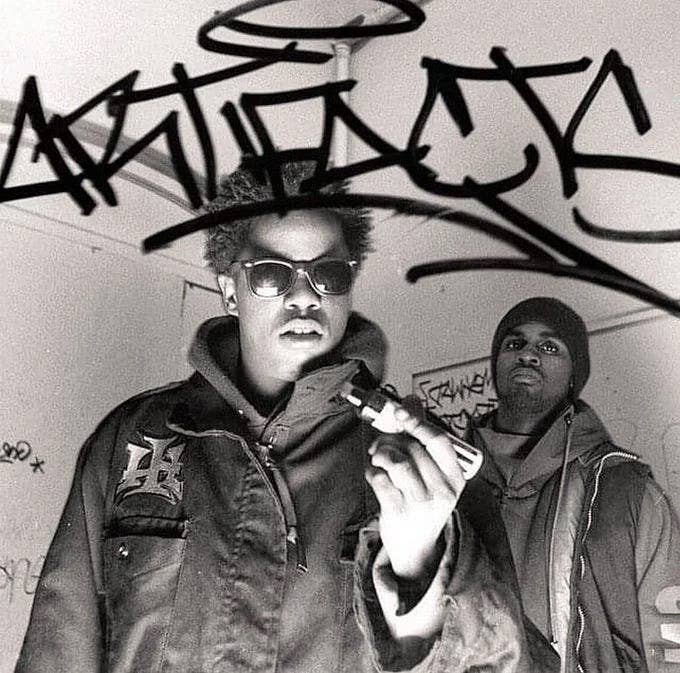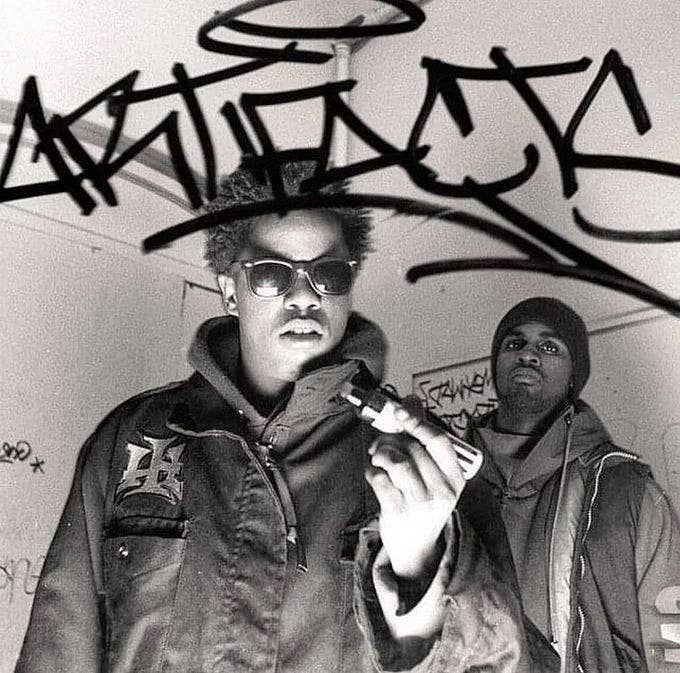
The most ethereal, unquantifiable, and unteachable quality a recording artist can possess is *cool.* You know, that supernatural mix of cultural precognition, absolute confidence, and utter nonchalance that congeal into an inescapable magnetism. You either have it or you don’t.
Tame One of The Artifacts had it. The Newark, New Jersey rapper, who passed away Sunday night from an apparent cardiac arrest at the far too young age of 52, was, for lack of a more elegant descriptor, cool as fuck.
Whether we’re talking about the pocket he found (and floated in) on beats or the way his jeans hit his Timbs or the effortlessness of his graffiti handstyles or how his M-65 jacket perfectly hugged his hoodie or how leaned his Wayfarers, or, or, or…the list goes on. Tame One, born Raheem Brown, just oozed—not unlike the leaky Uniwides his group would be so closely associated with—a casual charisma whose influence belied his sales or spins. The Artifacts were graffiti-writing Last of the Mohicans whose music celebrated hip-hop’s core trope of competitive creativity with outlaw, teenaged enthusiasm.
“Tame was like if a graffiti character straight up jumped off the wall,” says former A&R Rob “REEF” Tewlow, who signed Tame and his partner-in-rhyme El Da Sensei to Big Beat/Atlantic in 1992. Tewlow found the group via the Stretch Armstrong Show hosted by Bobbito the Barber, where, on a random Thursday night, Tame was the standout in a phone call-in battle. “Everything about him, from how he styled his hair to how he sagged his jeans to how he talked just had this dynamic, animated quality to it. Like you had to look at them. Actually when I first met the group they were going by the name That’s Them, because whenever they showed up at open mics everyone was like, ‘That’s them!!!’”
“Tame was like if a graffiti character straight up jumped off the wall.”
-Rob “REEF” Tewlow
Eventually the group would change their name to The Artifacts, lean into their “graffiti writer” marketing hook, and together with Tewlow they would assemble a top-tier crew of producers—including T-Ray, Buckwild and, oh, Tame’s cousin, Redman—to craft an undeniable underground classic, Between a Rock and a Hard Place. “The thing about Tame that was so special was his pocket,” explains Buckwild, who collaborated on the group’s most streamed song, “C’mon Wit Da Git Down.” “He approached every record differently and found the perfect place to sit on the beat. I just wish that his gift, musically, was appreciated by everyone—and not just the hip-hop community—because it was too special.”
One cannot overstate how influential that album and its accompanying visuals—be it their unbelievably perfect 12” jacket or subsequent music video for “Wrong Side of The Tracks” or simply the photos that accompanied their feature in The Source—were to a generation of weed-smoking, graffiti-writing, hip-hop obsessed teenagers (of whom, this journalist was one). In 1994, for a subset of rap fanatics, Tame and El were the blueprint. We wanted to dress like them. We wanted to write like them. Those of us who rapped (not I, said the fly) wanted to rap like them. Shit, our bedrooms were prop-styled facsimiles of the flicks of their home recording sessions.
Unfortunately, the timing of the group’s rise and eventual debut release made for a particularly challenging environment, commercially. That is to say, they got signed in ’92 when their rugged, blunted lyricism fit right in with the dominant sounds in East Coast hip-hop, i.e. Naughty, Tribe, and Cypress (who were, of course, from Cali, but adopted by NYC spiritually). However, they dropped their debut two years later, directly in the wake of the sea change that was Illmatic and Ready to Die. Those albums created a tectonic vibe shift—from earnest b-boy pugilism to more street-centric hustler narratives—and many once core hip-hop artists ended up purged onto alternate timelines. By the time their pretty excellent follow up, That’s Them, dropped in ’97, they remained critical darlings, but it was clear the group was operating on the periphery.
Not that you could tell from their disposition, or the content of their material. Where many of their peers were embittered by the shift—myopically obsessing about the state of the culture—The Artifacts neither reached nor reacted, having created an ardent following that transcended the mainstream hip-hop community into the worlds of skate and action sports. And their sound, style, and aesthetic would become foundational to the anti-commercial underground scene that emerged in the late ’90s (snidely christened “Backpack Rap”) and birthed artists like Eminem, Mos Def, MF DOOM, and El-P. In fact, Eminem thanked The Artifacts in his induction speech at the Rock N Roll Hall of Fame earlier this week.
And though the group broke up and lost their major label deal during that late-’90s transition, Tame’s talent endured. He embraced the early aughts wave of vinyl-first boom bap, finding new life in the Eastern Conference and Def Jux Records ecosystems. He put out lauded collaborative albums with Cage and Del tha Funky Homosapien, as well as a litany of solo projects. Eventually, he and El would reunite and the duo actually dropped an album, No Expiration Date, produced entirely by their longtime collaborator, Buckwild, that hit streaming this month.
“It’s just so sad,” says Buckwild. “We put out the album on vinyl a few months ago but you know, not that many people got to hear it off that. It just went wide on streaming last Thursday. Tame barely got to feel the reaction from the fans before he passed.”
“I just wish that his gift, musically, was appreciated by everyone—and not just the hip-hop community—because it was too special.”
-Buckwild
Although Tame never appeared invested in fame—beyond, of course, his ability to inspire jealousy in his pen peers (be they writers or rappers)—one has to hope that he passed with knowledge that his outsized influence was even more indelible than the burners he famously put up across Newark.
Tame One was the embodiment of a moment and a movement, and his art has stood the test of time. Between a Rock and a Hard Place still takes listeners right into a world of lawless adventuring in Dirty Jerz with startling vividness. And it still knocks.
“When I think of Tame I think of culture,” Buckwild says, his voice tightening. “Tame was culture.”
And culture lives infinite.

